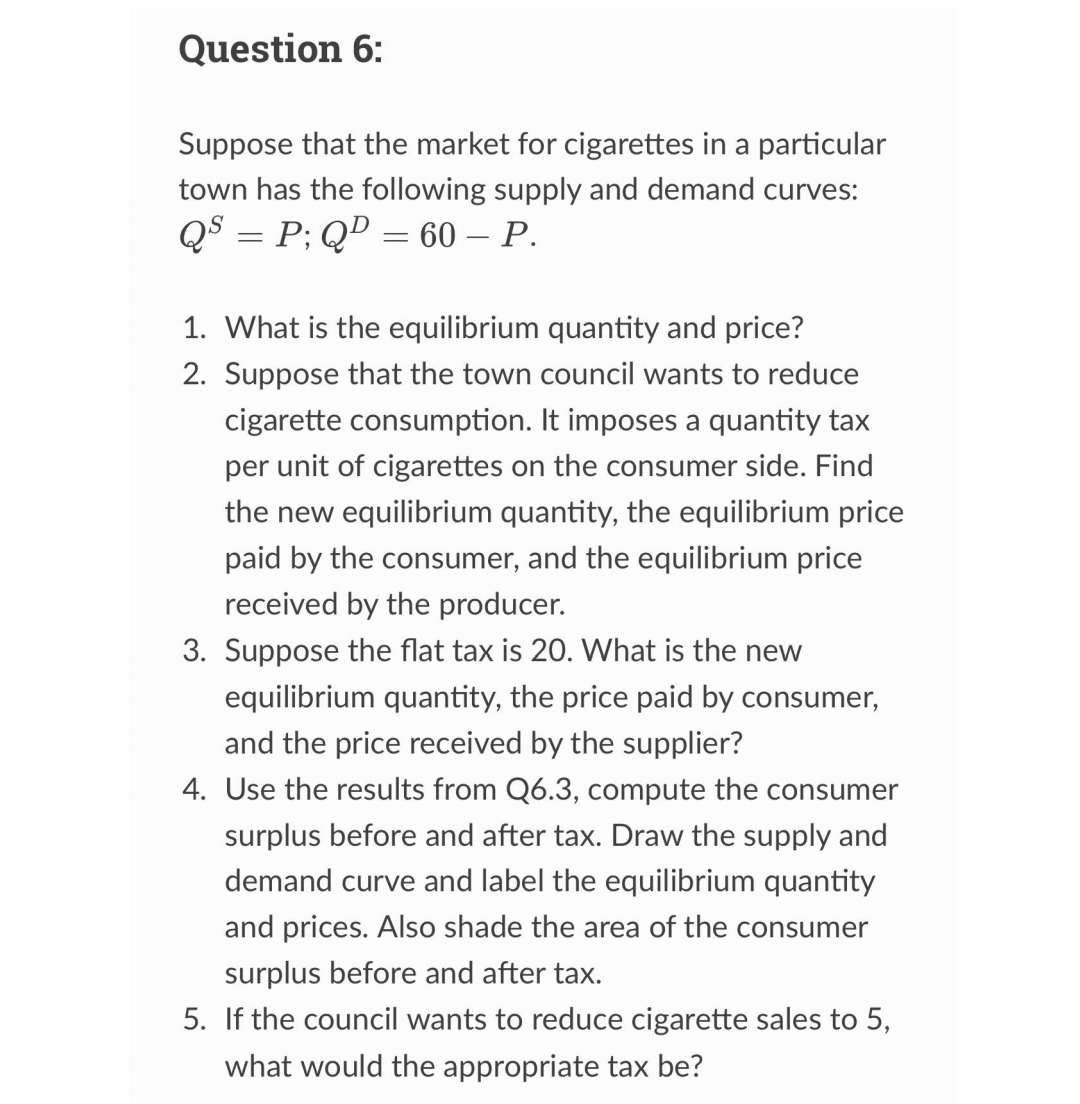Suppose that the market for cigarettes in a particular town has the following supply and demand curves: QS = P; QD = 60 – P. 1. What is the equilibrium quantity and price? 2. Suppose that the town council wants to reduce cigarette consumption. It imposes a quantity tax per unit of cigarettes on the consumer side. Find the new equilibrium quantity, the equilibrium price paid by the consumer, and the equilibrium price received by the producer. 3. Suppose the flat tax is 20. What is the new equilibrium quantity, the price paid by consumer, and the price received by the supplier?
Suppose that the market for cigarettes in a particular town has the following supply and demand curves: QS = P; QD = 60 – P. 1. What is the equilibrium quantity and price? 2. Suppose that the town council wants to reduce cigarette consumption. It imposes a quantity tax per unit of cigarettes on the consumer side. Find the new equilibrium quantity, the equilibrium price paid by the consumer, and the equilibrium price received by the producer. 3. Suppose the flat tax is 20. What is the new equilibrium quantity, the price paid by consumer, and the price received by the supplier?
Principles Of Marketing
17th Edition
ISBN:9780134492513
Author:Kotler, Philip, Armstrong, Gary (gary M.)
Publisher:Kotler, Philip, Armstrong, Gary (gary M.)
Chapter1: Marketing: Creating Customer Value And Engagement
Section: Chapter Questions
Problem 1.1DQ
Related questions
Question

Transcribed Image Text:Question 6:
Suppose that the market for cigarettes in a particular
town has the following supply and demand curves:
QS = P; QD = 60 - P.
1. What is the equilibrium quantity and price?
2. Suppose that the town council wants to reduce
cigarette consumption. It imposes a quantity tax
per unit of cigarettes on the consumer side. Find
the new equilibrium quantity, the equilibrium price
paid by the consumer, and the equilibrium price
received by the producer.
3. Suppose the flat tax is 20. What is the new
equilibrium quantity, the price paid by consumer,
and the price received by the supplier?
4. Use the results from Q6.3, compute the consumer
surplus before and after tax. Draw the supply and
demand curve and label the equilibrium quantity
and prices. Also shade the area of the consumer
surplus before and after tax.
5. If the council wants to reduce cigarette sales to 5,
what would the appropriate tax be?
Expert Solution
This question has been solved!
Explore an expertly crafted, step-by-step solution for a thorough understanding of key concepts.
This is a popular solution!
Trending now
This is a popular solution!
Step by step
Solved in 3 steps

Recommended textbooks for you

Principles Of Marketing
Marketing
ISBN:
9780134492513
Author:
Kotler, Philip, Armstrong, Gary (gary M.)
Publisher:
Pearson Higher Education,

Marketing
Marketing
ISBN:
9781259924040
Author:
Roger A. Kerin, Steven W. Hartley
Publisher:
McGraw-Hill Education

Foundations of Business (MindTap Course List)
Marketing
ISBN:
9781337386920
Author:
William M. Pride, Robert J. Hughes, Jack R. Kapoor
Publisher:
Cengage Learning

Principles Of Marketing
Marketing
ISBN:
9780134492513
Author:
Kotler, Philip, Armstrong, Gary (gary M.)
Publisher:
Pearson Higher Education,

Marketing
Marketing
ISBN:
9781259924040
Author:
Roger A. Kerin, Steven W. Hartley
Publisher:
McGraw-Hill Education

Foundations of Business (MindTap Course List)
Marketing
ISBN:
9781337386920
Author:
William M. Pride, Robert J. Hughes, Jack R. Kapoor
Publisher:
Cengage Learning

Marketing: An Introduction (13th Edition)
Marketing
ISBN:
9780134149530
Author:
Gary Armstrong, Philip Kotler
Publisher:
PEARSON


Contemporary Marketing
Marketing
ISBN:
9780357033777
Author:
Louis E. Boone, David L. Kurtz
Publisher:
Cengage Learning